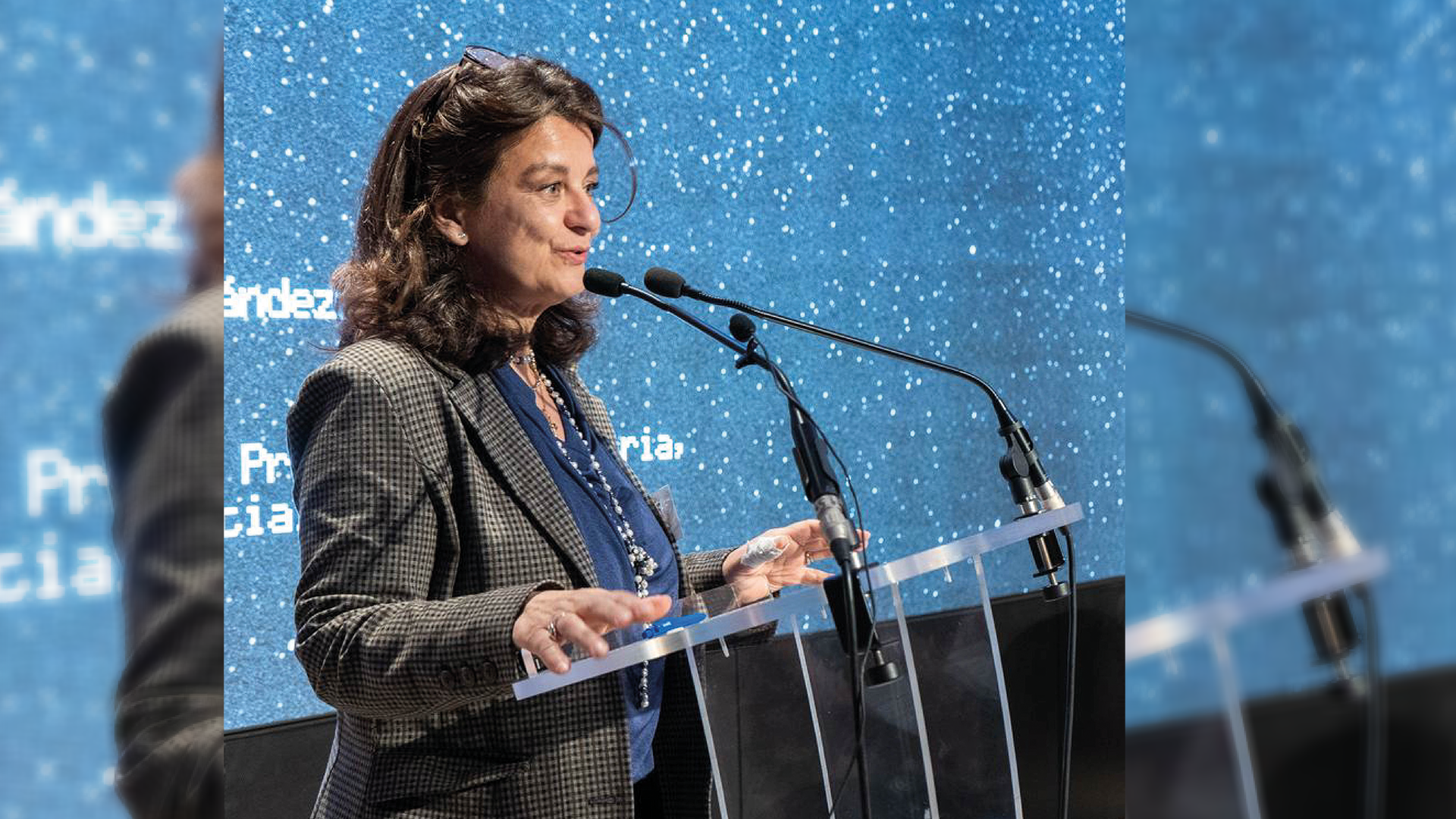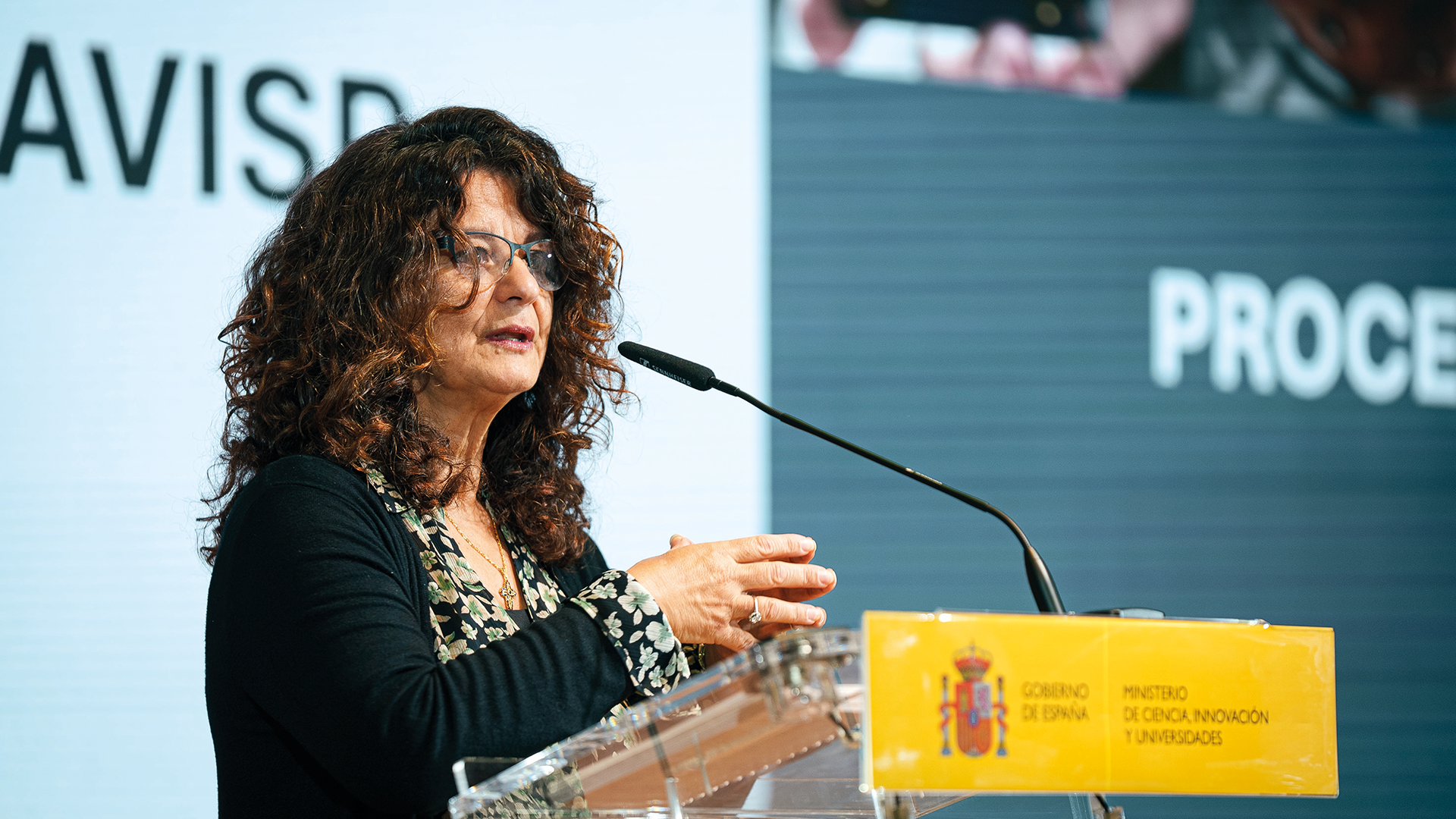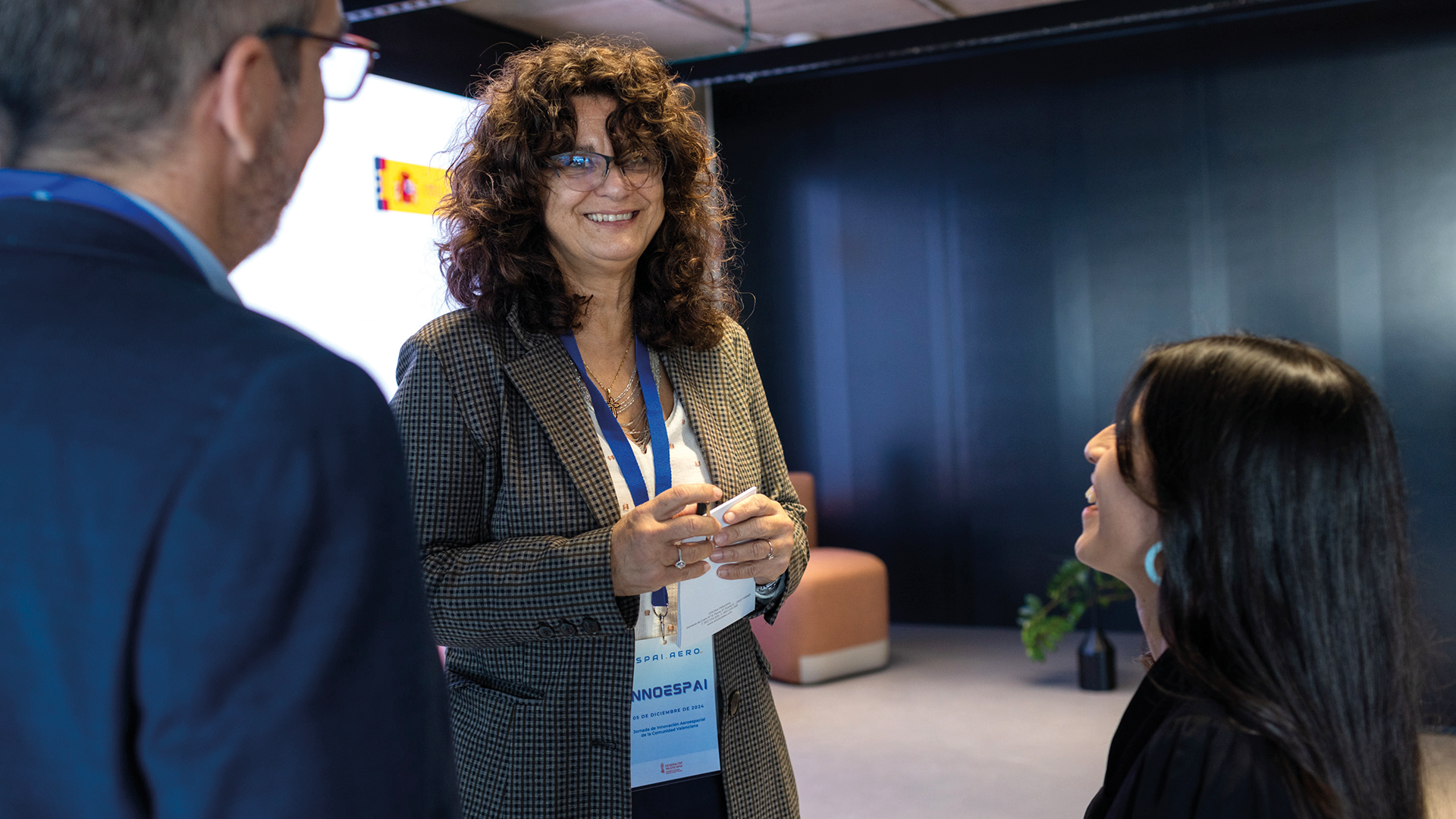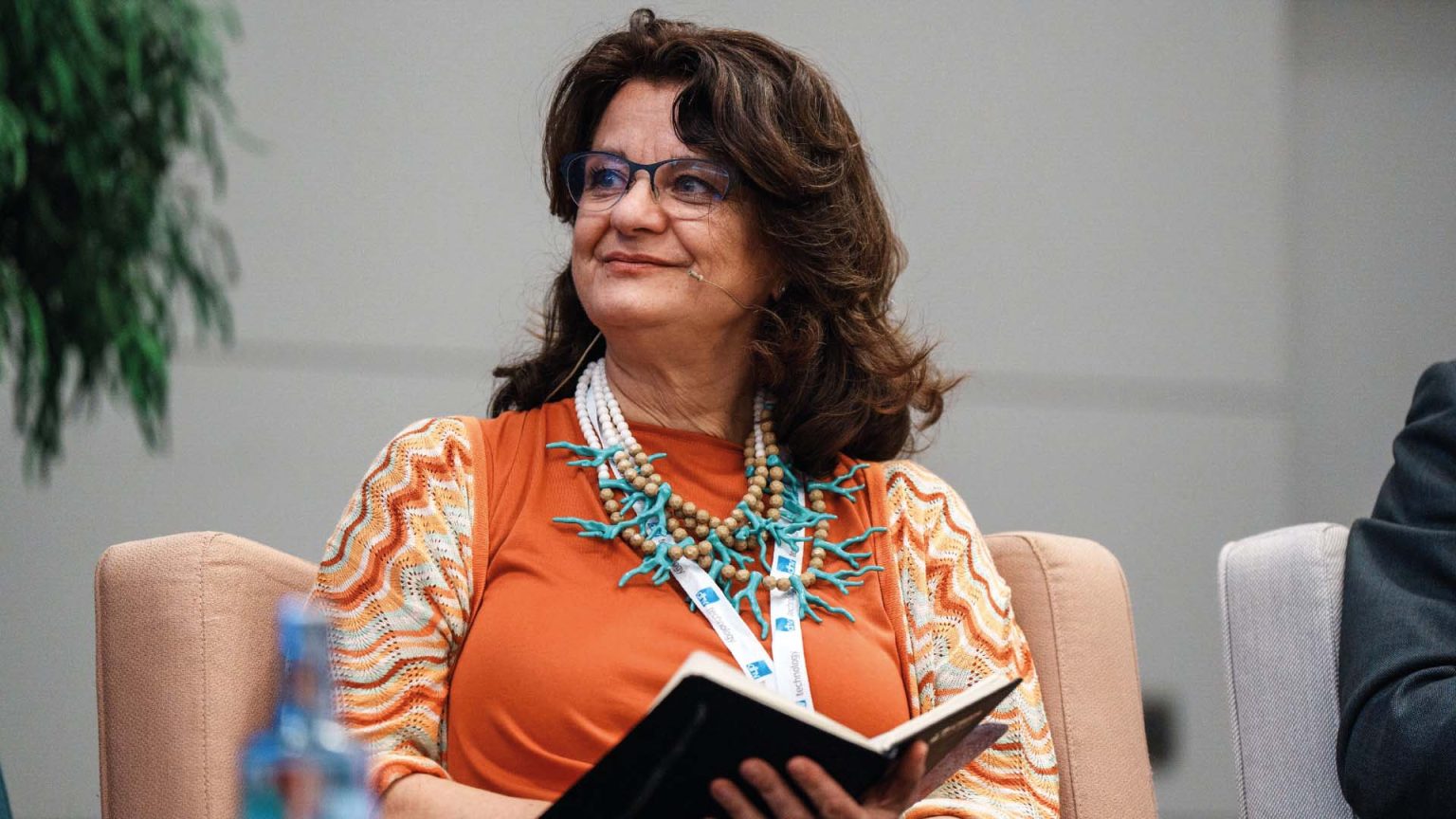Cecilia Hernández is the Director of Programmes and Industry at the Spanish Space Agency (AEE). She combines this role with the chair of the European Space Agency’s (ESA) Science Programme Committee and her responsibilities as a delegate on the ESA Council and a delegate and expert on other committees of the agency, as well as the European Union’s Space Programme.
When the Spanish Space Agency was formed, I was part of the CDTI team responsible for space matters, whose responsibilities were transferred directly to the Agency. I joined, also assuming my role as Chair of the Science Programme Committee and Delegate to the Industrial Policy Committee of ESA, among other responsibilities in the Spanish delegation to ESA.
At the AEE, I began my career as Head of the Science and Exploration Department, also temporarily assuming the functions of the International Programmes Department.
When the post I now hold at the AEE was declared open to public competition, I was convinced that I had the experience and profile necessary for the role.
In addition to having managed and represented Spain on space matters, I had gained solid experience in European Union programmes from the CDTI. I held responsibilities during several European Union R&D Framework Programmes as a representative, National Contact Point (NCP) and Head of Area, and was also a coordinator of NCPs in Spain.
During that period, I was a promoter and member of the Governing Council of various Spanish technology platforms, as well as a member of the group of state representatives in some of their European counterparts.
I sit on the Board of Directors of the Association of Women Researchers and Technologists, leading its Innovation hub, and am also committed to promoting scientific and technological careers”
In addition to all of the above, I have also been responsible for promotion, expert advice and analysis for various sectors and technologies as Head of Department at the CDTI.
All of this is rounded off by my previous experience in the private sector and at the CSIC (Spanish National Research Council).

My assessment can only be very positive.
The SPAINSAT NG programme, which involves two state-of-the-art satellites (SPAINSAT NG I and II), aims to provide secure, high-capacity communications to the Armed Forces and other Spanish government entities.
SPAINSAT NG strengthens Spain’s strategic autonomy by reducing external dependence and ensuring reliable communications even in critical situations. It consolidates Spain’s position as a leader in technological capabilities within NATO and the EU, boosting its competitive standing for joint projects. Compliance with NATO and GOVSATCOM standards facilitates international cooperation and opens up opportunities to position our technology.
The total budget for the SPAINSAT NG programme for both satellites is €868 million. Of this, €808 million comes from a reimbursable loan from the Ministry of Industry, Tourism and Trade, while the remaining €60 million comes from the CDTI and the AEE having been channelled through the ESA (European Space Agency).
The Ministry of Defence will pay a fee to Hisdesat for the use of the communication capabilities during its 15-year nominal lifespan. At the same time, strategies are being implemented to maximise the return on public and private investment, including the commercialisation of the satellite’s services to other governmental and commercial clients, both nationally and internationally.
The satellites incorporate advanced technologies such as anti-jamming and anti-spoofing protection, on-orbit reconfiguration flexibility and the use of “big data” and artificial intelligence. Notably, the development of innovative elements such as active X-band antennas through the PACIS 3 programme, has been financed with funds channelled through the ESA.
It is important to note that more than 40% of the development has been carried out by national industry.
There was a programme, a clear objective to achieve, and collaboration has ensured it became a reality. Now, precisely with the integrating role the AEEwas created to play, this type of programme will undoubtedly be strengthened, so the answer to the second question is yes, I hope we will achieve more milestones like this in the coming years.
How do you see the Spanish space industry? What are its main strengths and what should it focus on to achieve better performance?
The Spanish space industry stands out as a mature sector, well-positioned on the international stage. We have skills and innovative capacity that manifest themselves throughout its value chain, up to complete space systems, a growing ambition for leadership, and we hope to be able to launch satellites autonomously in the near future.
The foundation is solid, but times have changed, and we need to act more quickly to consolidate our leadership in an increasingly competitive global landscape.
Without a doubt, constant technological impetus and collaboration are two fundamental pillars on which to grow and improve capabilities. Strategic optimisation requires more coordinated and efficient management, like that which the Spanish Space Agency (AEE) seeks to facilitate, overcoming potential fragmentation and ensuring long-term planning that enhances synergies and avoids the dispersion of resources.
The Spanish space industry stands out as a mature and well-positioned sector on the international scene”
We must generate a robust ecosystem rooted in our country. In their strategies, companies must distinguish when to cooperate and when to compete, because there is no better way to be competitive than by competing, nor a better way to advance than by cooperating.
What are the current priorities of the AEE in terms of space industry and programmes?
This year, the Spanish Space AgencyAEEhas the priority of proposing a Space strategy. Its execution must materialise through plans with programmes that provide us with good capabilities and result in services.
At the AEE we are convinced that citizens must be clearly at the heart of our priorities. This requires building an autonomous, secure and competitive space capability.
We will maintain our focus on driving innovation and technological development, prioritising the execution of strategic space programmes, including autonomous access to space, which will give us sovereignty and contribute to improving security and defence. In the international arena, in addition to enhancing participation in the ESA programmes and the European Union Space Programme, we will increase bilateral collaboration programmes.
For this year 2025, at the Programmes Directorate, our main task is to prepare for the ESA Ministerial Council, which will be held in Bremen (Germany) in November, and where the programmes and investments for the next period will be decided.
At the AEE we are immersed in shaping the proposals with the ESA and the countries. Our contribution must be ambitious, but also realistic. With an eye to the long term, we need to balance our level of subscriptions to the programmes we are committed to, generating positioning and competitive advantages for the ESA in general and for our country in particular. We are working on the basis of the 2040 strategy recently published, after being approved by the ESA Council. And this strategy is the one that will have to be put into practice.
In parallel, the financial perspectives for the next European Union budgetary framework are being discussed, framing what the Union’s commitment to space will be and how the continuation and evolution of the current EU Space Programme will be configured.

The Spanish Space Agency (AEE) has embraced innovation as a fundamental element for competitiveness:
The first thing we launched as an agency after the Director took office was the call for the Space Technology Plan (PTE), which was very well received by the sector, and which we will continue.
In addition to innovation, through this tool we have stimulated collaboration between companies, paying special attention to integrating SMEs, as well as the relationship with universities, research institutes and technology centres, favouring transfer processes.
We conceive the PTE as a strategic anticipation tool that responds to emerging trends in the sector, with the ambition of providing Spain with industrial capabilities and to better prepare our most strategic programmes.
The technology programmes with the European Space Agency (ESA) complement a process that also contributes to the international visibility of our current and developing capabilities.
In the last year, as a first in Spain, we have used this tool to prioritise areas such as lunar exploration, where we seek to become a relevant player, position ourselves in optical communications and expand on technological solutions to respond to climate emergencies.
For its part, the Atlantic Constellation is a strategic programme for us that is here to stay. It will give us capabilities for Earth observation and is opening the doors for collaborations with other countries besides Portugal, which is who we conceived it with.
In any case, we must also pay attention to the initiatives undertaken, follow them up, evaluate them, and continue or reorient them as the case may be.
Finally, international collaboration is essential to stay at the forefront, whether through ESA, EU or other bilateral or multilateral collaboration programmes.
The Atlantic Constellation is a strategic programme for us that is here to stay”
The future of the space industry is intrinsically linked to the convergence of technologies. Reducing mass to lower launch costs, providing agility and security in communications, promoting a sustainable development of space, being more efficient, being better protected and ensuring that space services are provided correctly is achieved by facilitating the incorporation of disruptive technologies.
Photonic processes make it possible to obtain information on distant galaxies, the composition of the Earth’s atmosphere and the mechanisms of climate change. They multiply the capacity of data transfer and help us with accurate measurements and positioning of satellites; quantum key distribution technologies -QKD- will provide us with greater efficiency and security in communications.
Quantum computing, although still in its early stages, presents great potential for the analysis of the huge amount of space data we already handle. Artificial intelligence (AI), for its part, will accelerate decision-making processes, which translates into greater efficiency and viability of future missions. The development of new materials, nanotechnologies and quantum technologies will give us lighter and more resistant structures, new functionalities that will allow miniaturisation and improved performance of sensors and components.
The Spanish Space Agency (AEE) has the function of representing Spain in international Space forums. As part of the European Union and members of the European Space Agency, it is our obligation and ambition to contribute to enhancing capabilities on the continent by joining forces and collaborating among all states.
The opening up of national programmes to other collaborations also contributes to strengthening the European landscape. In Europe, we are aware that we cannot afford to have dependencies on the outside and that we must work to reduce them.
It is essential that ESA and EU programmes are defined in a coordinated and aligned manner. The mission of the AEE in this context is to present our country as a reliable partner, a key player
in the development of a strong, independent and secure European Space sector, capable of meeting its own strategic needs, fostering innovation and contributing to the security and prosperity of Europe.
However, public-private collaboration also presents challenges: It is crucial to establish a clear regulatory framework, with effective oversight mechanisms to ensure transparency and avoid potential conflicts of interest. The definition of common objectives, roles and responsibilities between public and private entities is also essential for the success of the collaboration.
Regarding the economic impact, let’s take as a reference the data from the latest TEDAE report: the Space sector has contributed to the Spanish economy €1.96Bn of its GDP, 20,552 jobs, €887M in exports, €354M in R&D, and €696M in collected taxes.
For every euro generated directly in 2023, the Space sector has contributed to the national GDP with 2 euros. Exports represent an improvement in the trade balance and demonstrate the country’s international competitiveness.
The development of Space technologies requires great efforts in research and development (R&D). These investments not only drive innovation in the space sector, but also benefit other economic sectors.
Many innovations that arise in the Space sector end up permeating other sectors. The investment of companies in the sector in R&D exceeds the average of Spanish manufacturing companies by 8 percentage points.
The Space sector creates highly qualified employment. The high productivity of these jobs (up to 88% above the average for Spanish industry) generates an additional economic impact.
With regard to social development, space programmes contribute to the improvement of public services such as communications, meteorology, monitoring of the environment and the effects of climate change, pollution, emergency management and navigation assistance.

Los datos obtenidos por los satélites permiten la vigilancia y respuesta a emergencias ambientales así como la gestión eficiente de recursos (agrícolas, hídricos y forestales).
The data obtained by satellites allow the surveillance and response to environmental emergencies as well as the efficient management of resources (agricultural, water and forestry).
Success in space exploration and in the development of space technologies enhances Spain’s international prestige and attracts foreign investment.
The AEE places citizens at the heart of its actions, and security is today one of society’s greatest concerns.
Space has become a strategic domain, and its control is fundamental to the protection of national interests. It is necessary to preserve our own space assets, as well as the development of surveillance, intelligence and response systems to potential threats.
Investment in technological research and development and the promotion of initiatives aimed at innovation in key areas for defence ensures that Spain has the necessary technologies to ensure its presence in the Space sector and protect its sovereignty in this domain.
ESA has announced that the next meeting of its Ministerial Council will take place in Bremen in November 2025. It will be the first time that Spain will participate with its own Space Agency, as was already the case for the main European countries.
Spain has substantially increased its annual contribution to the ESA, from €202 million in 2018 to €300 million in 2025, almost 50%. However, its contribution in percentage terms is still at 5.5% compared to a relative GDP of 7.13%.
Bearing in mind that the mandatory contribution (mainly includes the scientific programme and basic activities) is made according to GDP, our margin for improvement is mainly found in the optional programmes.
The AEE has been preparing for the ESA Ministerial Conference of 2025 (CM25) for some time now. We participate in the preparatory working groups and do so in permanent dialogue with the stakeholders in our country, also analysing our past experience and recognised capabilities of our industrial sector. At the programme level, the details are discussed and then elevated to the level of the Council working group specifically created to prepare the CM25, which has so far held two meetings. Preparatory activities with industry have been initiated from some programmes, which we have joined.
On the other hand, for several months we’ve been meeting with companies and other key players in the ecosystem, gathering their interests and future-focused proposals regarding their capabilities and strategies. Alongside our discussions with the ESA and other nations, we’ve recently launched a survey as part of this consultation process.
This was timed just after the ESA presented its proposal to industry over two intensive days dedicated to covering the full spectrum of ESA programmes and activities (ESTEC, 3rd and 4th April). The responses will help us to better focus our approach.
We want to reinforce areas where Spain already holds a position of leadership, consolidating our past and present strengths and paving the way for new opportunities within the programmes that will shape the ESA’s proposal for CM25.
In addition to participating in mandatory and optional ESA programmes, we hope to continue using the “third parties” mechanism which allows us to implement national priorities.
Space has become a strategic domain, and its control is fundamental to the protection of national interests”
We will continue to engage with the Spanish sector as the programmes are defined in more detail. We’ll refine the priorities, and based on the financial projections, we’ll fit our participation into the programmes. It’s an iterative process, unfolding on several levels.
The result must be a subscription proposal that is affordable for Spain, within the spending limit that the Council of Ministers ultimately approves. That’s why it’s so important that we can establish a well-founded prioritisation with a realistic spending forecast.
Obviously, in an environment of European cooperation, we need to negotiate and agree on programme participation with the other ESA member states, as well as agree on their operating rules. The debate we’re having within the ESA, especially for some programmes, is also being conducted with an eye on the European Union. Deep coordination between the ESA and the European Commission is needed when designing the programmes that will build the future.





